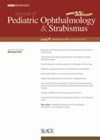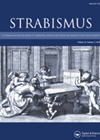
Journal Reviews
Effect of one versus 24 hours diagnostic occlusion
The purpose of this study was to compare measurements taken after one and 24 hours of diagnostic occlusion in cases of basic and divergence excess types of intermittent exotropia. This was a prospective study of 43 patients (34 females) with...
Manual versus photo screening comparisons
This study was designed and undertaken to compare the results obtained from the SPOT vision screener and PlusOptix vision screener versus manual screening results in preschool children. Manual screening used LEA symbols and stereo butterfly tests. Over a three-month period,...
Exotropia control score versus angle
The authors aimed to evaluate the relationship between family history and deviation control in intermittent exotropia, and the effects of age, sex, angle and refractive status on deviation control. This was retrospective review of 54 patients aged 7.7 ±4 years...
Association of sleep problems in children with visual impairment
The intention of this study was to investigate sleep problems in children who had a wide range of visual impairments. Recruitment was via an online survey distributed through the National Federation of Blind and National Organisation for Albinism and Hypopigmentation,...
Complications of limbal stay sutures
There is limited literature describing complications at the limbal suture site. The authors describe two cases with postoperative complications due to use of intraoperative limbal stay sutures. Each case had strabismus surgery at other centres but with presentation to the...
Surgical technique for small-angle hypertropia
In order to treat small-angle hypertropia of <5PF associated with mild / moderate upshoot in adduction, an option is to suture the inferior oblique (IO) belly to the sclera following its natural muscle direction or with anterior transposition. This study...
Factors associated with seeking delayed strabismus surgery
The purpose of this study was to investigate the main reasons for delay in strabismus surgery and assess patients’ motivations to undergo strabismus surgery in adulthood. This was a prospective study in the Republic of Moldova of 91 patients with...
AACE associated with excessive smartphone use
The purpose of this study was to describe a series of cases of acute acquired comitant strabismus (AACE) in children attending online classes on smartphones during the pandemic. Eight children were included with a mean age of 12.5 ±4.2 years....
Cost-effectiveness of orthoptic-delivered screening versus school nurse screening
The authors describe a long-term audit of outcomes and costs associated with referrals from two established neighbouring school-entry vision screening services in the UK over one academic year with one adhering to national UK screening guidelines more closely than the...
OCT findings after strabismus surgery for macular, choroidal and nerve fibre thickness
This study used OCT to investigate the changes in the central macular thickness, subfoveal choroidal thickness (SFCT) and retinal nerve fibre layer (RNFL) after horizontal rectus surgery for patients with strabismus. This was a retrospective study and patients were grouped...
Attitudes to strabismus in an Ethiopian population
The authors conducted a community-based cross-sectional study in Gondar town (NW Ethiopia) in April 2019 of all eligible adults with a two-stage random sampling procedure for recruitment. Six hundred and two participants were included with a response rate of 94.9%...
Corneal dellen following strabismus surgery
This study aimed to evaluate the frequency of corneal dellen (CD) development, the healing process and associated factors that affect the development and healing of CD formation after strabismus surgery. This study retrospectively reviewed 1264 eyes of 714 patients from...






